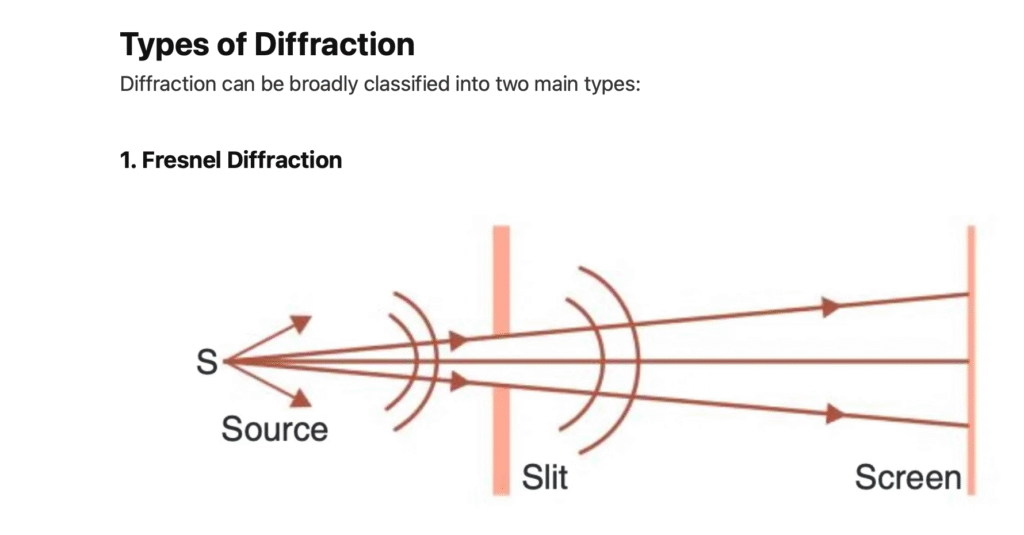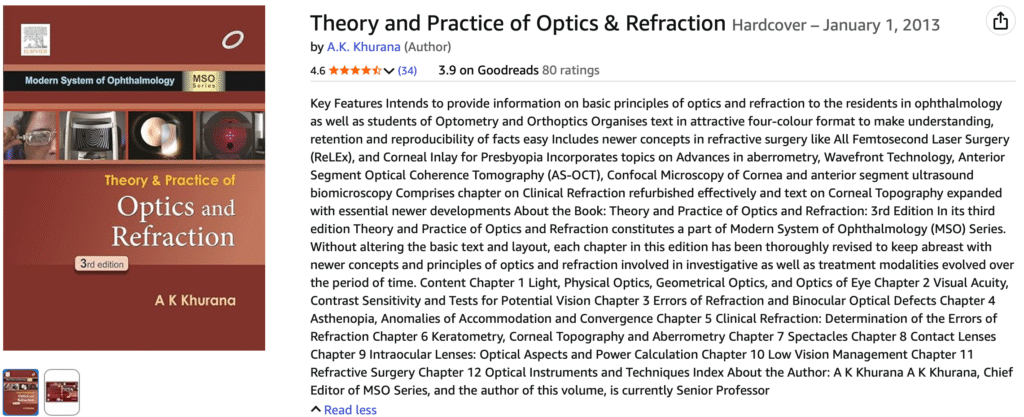
Notes on Diffraction of Light
What is Diffraction of Light?
Light usually travels in straight lines, forming sharp shadows and clearly defined illuminated regions. However, this behavior changes when light encounters an obstacle or aperture whose size is comparable to its wavelength. Under such conditions, light bends around edges or spreads as it passes through openings — a phenomenon known as diffraction.
Diffraction demonstrates that light is a wave and not simply a stream of particles. Understanding it is essential not only in physics but also in physiological optics, as it directly affects image formation in the human eye and the resolution of optical instruments.
The Concept of Diffraction
When an opaque obstacle or aperture is placed between a light source and a screen, a shadow or illuminated region forms according to the principle of rectilinear propagation.
- If the aperture size is much larger than the wavelength of light, the light travels in straight lines, producing a sharp image or shadow.
- But if the aperture or obstacle size is comparable to the wavelength, the light deviates slightly near the edges and spreads into the shadow region.
This spreading of light into regions that would otherwise be dark is called diffraction.
Types of Diffraction
Diffraction can be broadly classified into two main types:
1. Fresnel Diffraction

- Occurs when the light source or the screen (or both) are at a finite distance from the diffracting object.
- The diffraction pattern formed is essentially a modified shadow of the obstacle or aperture due to interference between secondary wavelets.
- Common examples include:
- Diffraction at a straight edge
- Diffraction at a narrow slit
- Diffraction at a small opaque disc
This type is usually analyzed using Fresnel’s half-period zones and is observed without using lenses.
2. Fraunhofer Diffraction

- Occurs when both the source and the screen are effectively at infinity, or lenses are used to make light rays parallel and focus the diffracted pattern.
- The pattern represents the image of the source modified by diffraction effects.
- Typical examples:
- Diffraction at a single slit
- Diffraction at a double slit
- Diffraction grating
Fraunhofer diffraction is easier to study mathematically because the light waves involved are plane and parallel.
Applied Aspects of Diffraction in Optics
Diffraction is not just a laboratory phenomenon — it has direct implications in vision and optical instruments.
1. Diffraction and Visual Acuity
- When the pupil size is smaller than about 2.5 mm (in emmetropic eyes), diffraction becomes significant.
- The image of a distant point source on the retina takes the form of a blur circle, known as the Airy disc.
- A smaller aperture (or pupil) produces a larger Airy disc, leading to decreased visual sharpness.
Thus, while a small pupil can reduce optical aberrations, excessive reduction increases diffraction, limiting visual acuity.
2. Diffraction and Pinhole Vision
- During a pinhole test, if the aperture is too small, the benefits of increased depth of focus are offset by diffraction.
- The secondary wavefronts from the aperture edges interfere, reducing clarity and brightness of the retinal image.
3. Diffraction and Glare
- Halos and glare seen around bright lights (especially at night) may result from diffraction effects due to small apertures or scattering structures in the eye.
4. Dependence on Wavelength
- Light with a longer wavelength (red) diffracts more strongly than light with a shorter wavelength (blue).
- Hence, the Airy disc for red light is larger than that for blue light.
5. Diffraction and Resolution of Optical Instruments
- Every optical instrument, including the eye, microscope, and telescope, has its resolving power limited by diffraction.
- The minimum resolvable distance between two points is approximately equal to the radius of the Airy disc.
- Beyond a certain precision, improving the optical quality of lenses does not significantly enhance image resolution because diffraction imposes a fundamental limit.
Summary
| Parameter | Fresnel Diffraction | Fraunhofer Diffraction |
|---|---|---|
| Source and screen distance | Finite | Infinite (or made parallel using lenses) |
| Type of wavefront | Spherical | Plane |
| Pattern nature | Modified shadow | Image of the source |
| Examples | Edge, slit, opaque disc | Single slit, double slit, grating |
Conclusion
Diffraction reveals the wave nature of light and explains many optical limitations — from the finite resolution of instruments to the limits of human vision through a small pupil. In physiological optics, it underlines the delicate balance between aperture size, light intensity, and visual clarity. Understanding diffraction helps optometrists and vision scientists appreciate why perfect optical systems still face limits in resolution and how these constraints shape both clinical testingand optical design.
Book reference : Theory and practice of Refraction (Amazon)

